Note: This question is part of a series of questions that present the same scenario. Each question in the series contains a unique solution that might meet the stated goals. Some question sets might have more than one correct solution, while others might not have a correct solution.
After you answer a question in this section, you will NOT be able to return to it. As a result, these questions will not appear in the review screen.
You plan to create an Azure Databricks workspace that has a tiered structure. The workspace will contain the following three workloads:
✑ A workload for data engineers who will use Python and SQL.
✑ A workload for jobs that will run notebooks that use Python, Scala, and SQL.
✑ A workload that data scientists will use to perform ad hoc analysis in Scala and R.
The enterprise architecture team at your company identifies the following standards for Databricks environments:
✑ The data engineers must share a cluster.
✑ The job cluster will be managed by using a request process whereby data scientists and data engineers provide packaged notebooks for deployment to the cluster.
✑ All the data scientists must be assigned their own cluster that terminates automatically after 120 minutes of inactivity. Currently, there are three data scientists.
You need to create the Databricks clusters for the workloads.
Solution: You create a Standard cluster for each data scientist, a High Concurrency cluster for the data engineers, and a High Concurrency cluster for the jobs.
Does this meet the goal?
Answer:
A
We need a High Concurrency cluster for the data engineers and the jobs.
Note: Standard clusters are recommended for a single user. Standard can run workloads developed in any language: Python, R, Scala, and SQL.
A high concurrency cluster is a managed cloud resource. The key benefits of high concurrency clusters are that they provide Apache Spark-native fine-grained sharing for maximum resource utilization and minimum query latencies.
Reference:
https://docs.azuredatabricks.net/clusters/configure.html
You are designing a folder structure for the files in an Azure Data Lake Storage Gen2 account. The account has one container that contains three years of data.
You need to recommend a folder structure that meets the following requirements:
✑ Supports partition elimination for queries by Azure Synapse Analytics serverless SQL pools
✑ Supports fast data retrieval for data from the current month
✑ Simplifies data security management by department
Which folder structure should you recommend?
Answer:
A
Department top level in the hierarchy to simplify security management.
Month (MM) at the leaf/bottom level to support fast data retrieval for data from the current month.
You have an Azure subscription that contains an Azure Synapse Analytics dedicated SQL pool named Pool1. Pool1 receives new data once every 24 hours.
You have the following function.
You have the following query.
The query is executed once every 15 minutes and the @parameter value is set to the current date.
You need to minimize the time it takes for the query to return results.
Which two actions should you perform? Each correct answer presents part of the solution.
NOTE: Each correct selection is worth one point.
Answer:
BD
D: When result set caching is enabled, dedicated SQL pool automatically caches query results in the user database for repetitive use. This allows subsequent query executions to get results directly from the persisted cache so recomputation is not needed. Result set caching improves query performance and reduces compute resource usage. In addition, queries using cached results set do not use any concurrency slots and thus do not count against existing concurrency limits.
Incorrect:
Not A, not C: No joins so index not helpful.
Not E: What is a replicated table?
A replicated table has a full copy of the table accessible on each Compute node. Replicating a table removes the need to transfer data among Compute nodes before a join or aggregation. Since the table has multiple copies, replicated tables work best when the table size is less than 2 GB compressed. 2 GB is not a hard limit. If the data is static and does not change, you can replicate larger tables.
Reference:
https://docs.microsoft.com/en-us/azure/synapse-analytics/sql-data-warehouse/performance-tuning-result-set-caching
DRAG DROP -
You have an Azure Active Directory (Azure AD) tenant that contains a security group named Group1. You have an Azure Synapse Analytics dedicated SQL pool named dw1 that contains a schema named schema1.
You need to grant Group1 read-only permissions to all the tables and views in schema1. The solution must use the principle of least privilege.
Which three actions should you perform in sequence? To answer, move the appropriate actions from the list of actions to the answer area and arrange them in the correct order.
NOTE: More than one order of answer choices is correct. You will receive credit for any of the correct orders you select.
Select and Place: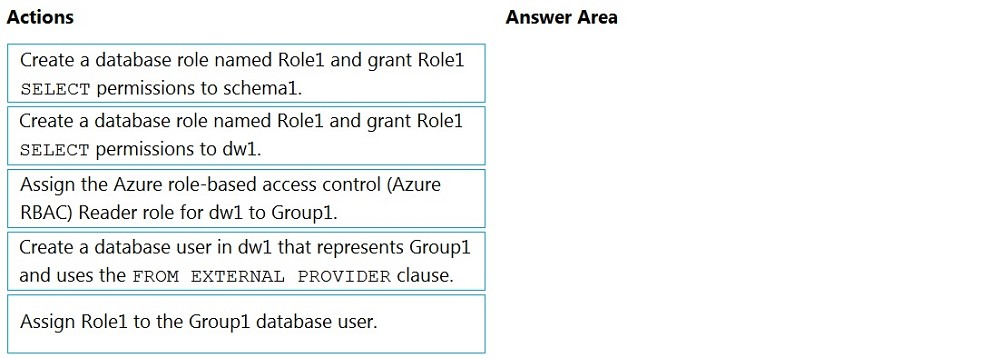
Answer:
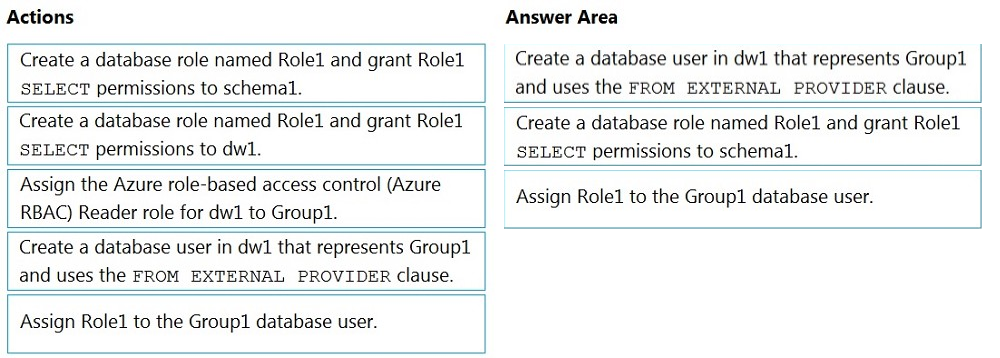
Step 1: Create a database user named dw1 that represents Group1 and use the FROM EXTERNAL PROVIDER clause.
Step 2: Create a database role named Role1 and grant Role1 SELECT permissions to schema1.
Step 3: Assign Role1 to the Group1 database user.
Reference:
https://docs.microsoft.com/en-us/azure/data-share/how-to-share-from-sql
HOTSPOT -
You have an Azure subscription that contains a logical Microsoft SQL server named Server1. Server1 hosts an Azure Synapse Analytics SQL dedicated pool named Pool1.
You need to recommend a Transparent Data Encryption (TDE) solution for Server1. The solution must meet the following requirements:
✑ Track the usage of encryption keys.
Maintain the access of client apps to Pool1 in the event of an Azure datacenter outage that affects the availability of the encryption keys.
What should you include in the recommendation? To answer, select the appropriate options in the answer area.
NOTE: Each correct selection is worth one point.
Hot Area: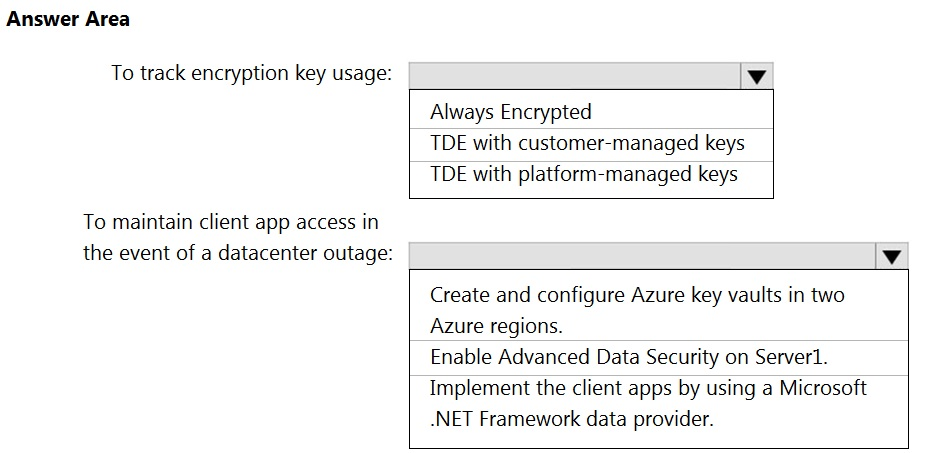
Answer:
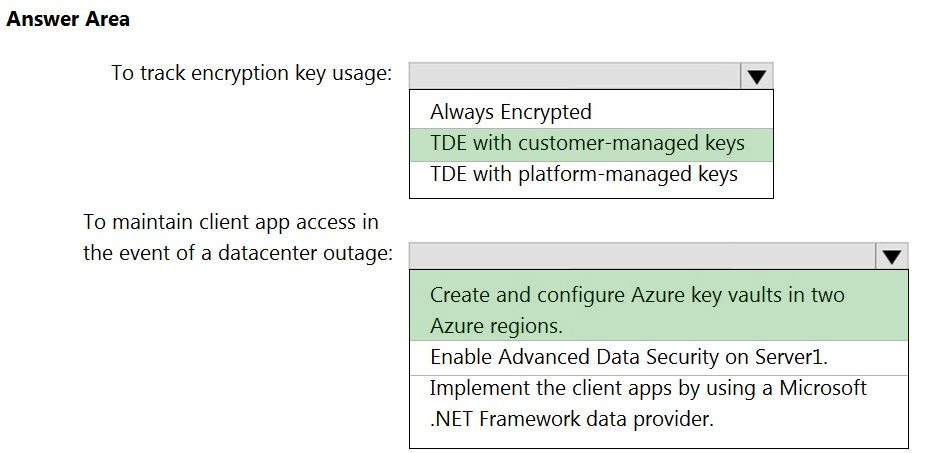
Box 1: TDE with customer-managed keys
Customer-managed keys are stored in the Azure Key Vault. You can monitor how and when your key vaults are accessed, and by whom. You can do this by enabling logging for Azure Key Vault, which saves information in an Azure storage account that you provide.
Box 2: Create and configure Azure key vaults in two Azure regions
The contents of your key vault are replicated within the region and to a secondary region at least 150 miles away, but within the same geography to maintain high durability of your keys and secrets.
Reference:
https://docs.microsoft.com/en-us/azure/synapse-analytics/security/workspaces-encryption https://docs.microsoft.com/en-us/azure/key-vault/general/logging
You plan to create an Azure Synapse Analytics dedicated SQL pool.
You need to minimize the time it takes to identify queries that return confidential information as defined by the company's data privacy regulations and the users who executed the queues.
Which two components should you include in the solution? Each correct answer presents part of the solution.
NOTE: Each correct selection is worth one point.
Answer:
AC
A: You can classify columns manually, as an alternative or in addition to the recommendation-based classification: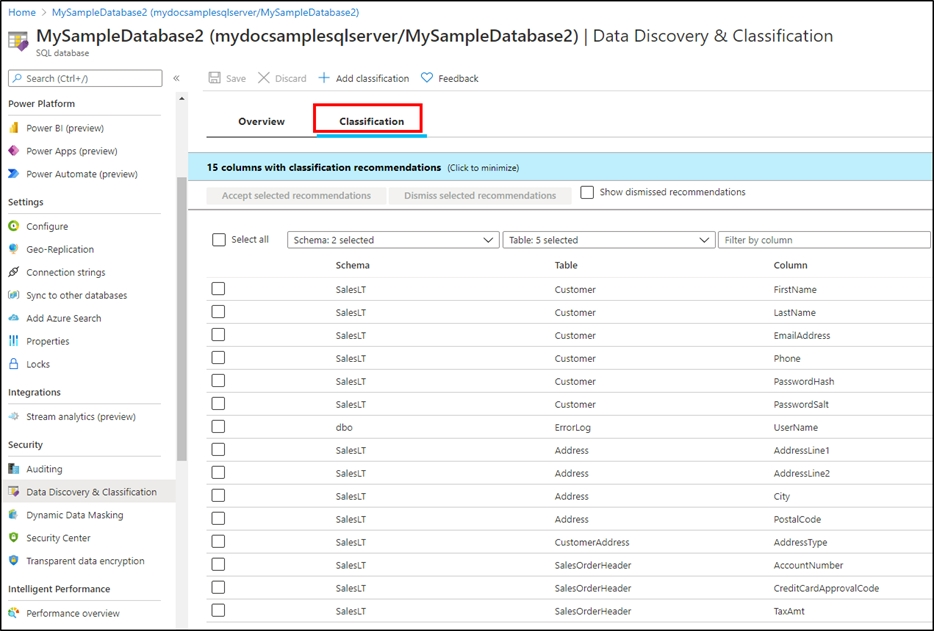
1. Select Add classification in the top menu of the pane.
2. In the context window that opens, select the schema, table, and column that you want to classify, and the information type and sensitivity label.
3. Select Add classification at the bottom of the context window.
C: An important aspect of the information-protection paradigm is the ability to monitor access to sensitive data. Azure SQL Auditing has been enhanced to include a new field in the audit log called data_sensitivity_information. This field logs the sensitivity classifications (labels) of the data that was returned by a query. Here's an example:
Reference:
https://docs.microsoft.com/en-us/azure/azure-sql/database/data-discovery-and-classification-overview
You need to design a solution that will process streaming data from an Azure Event Hub and output the data to Azure Data Lake Storage. The solution must ensure that analysts can interactively query the streaming data.
What should you use?
Answer:
B
You are creating an Apache Spark job in Azure Databricks that will ingest JSON-formatted data.
You need to convert a nested JSON string into a DataFrame that will contain multiple rows.
Which Spark SQL function should you use?
Answer:
A
DRAG DROP
-
You have an Azure subscription that contains an Azure Databricks workspace. The workspace contains a notebook named Notebook1.
In Notebook1, you create an Apache Spark DataFrame named df_sales that contains the following columns:
• Customer
• SalesPerson
• Region
• Amount
You need to identify the three top performing salespersons by amount for a region named HQ.
How should you complete the query? To answer, drag the appropriate values to the correct targets. Each value may be used once, more than once, or not at all. You may need to drag the split bar between panes or scroll to view content.
NOTE: Each correct selection is worth one point.
Answer:

HOTSPOT -
You are designing an Azure Synapse Analytics dedicated SQL pool.
Groups will have access to sensitive data in the pool as shown in the following table.
You have policies for the sensitive data. The policies vary be region as shown in the following table.
You have a table of patients for each region. The tables contain the following potentially sensitive columns.
You are designing dynamic data masking to maintain compliance.
For each of the following statements, select Yes if the statement is true. Otherwise, select No.
NOTE: Each correct selection is worth one point.
Hot Area: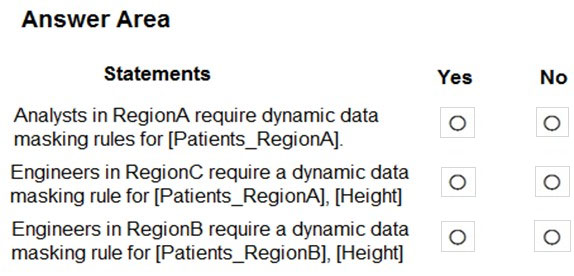
Answer:
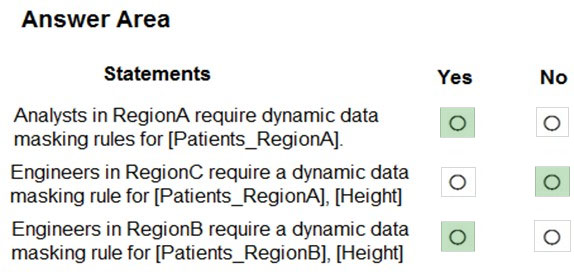
Reference:
https://docs.microsoft.com/en-us/azure/azure-sql/database/dynamic-data-masking-overview